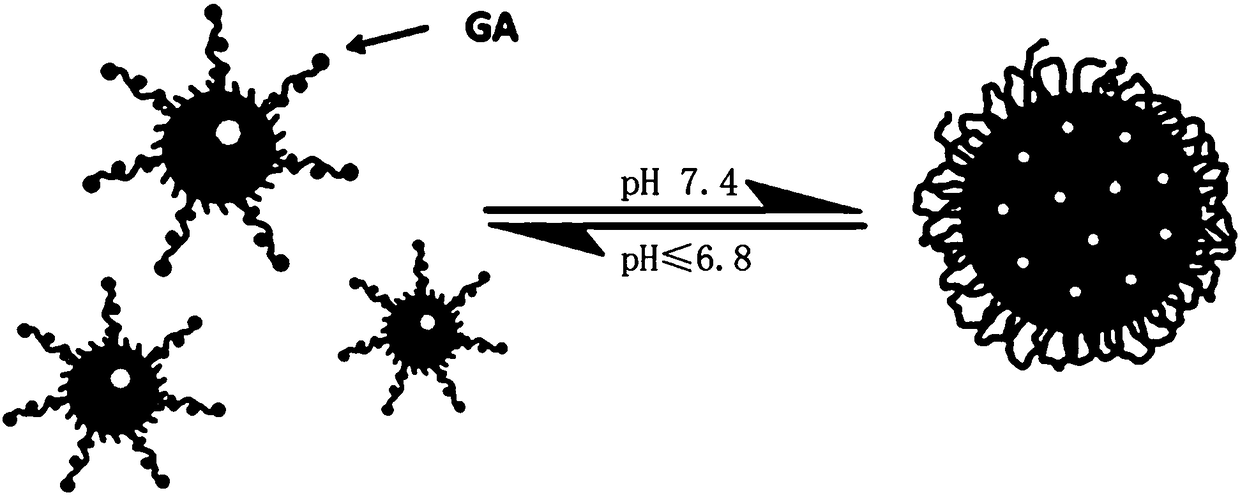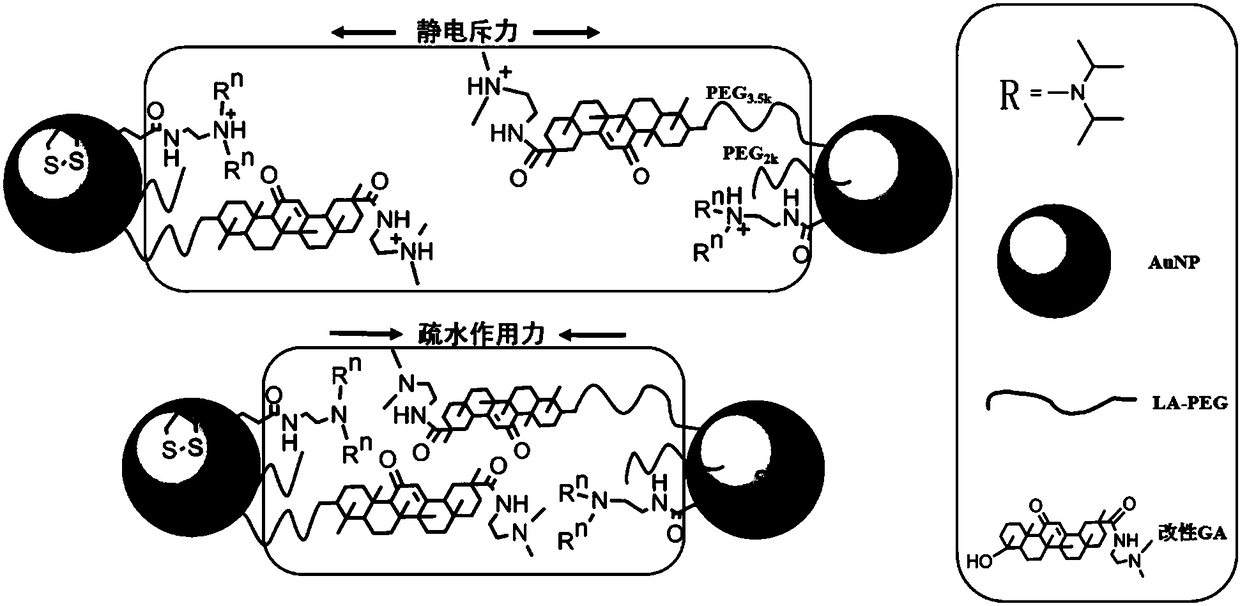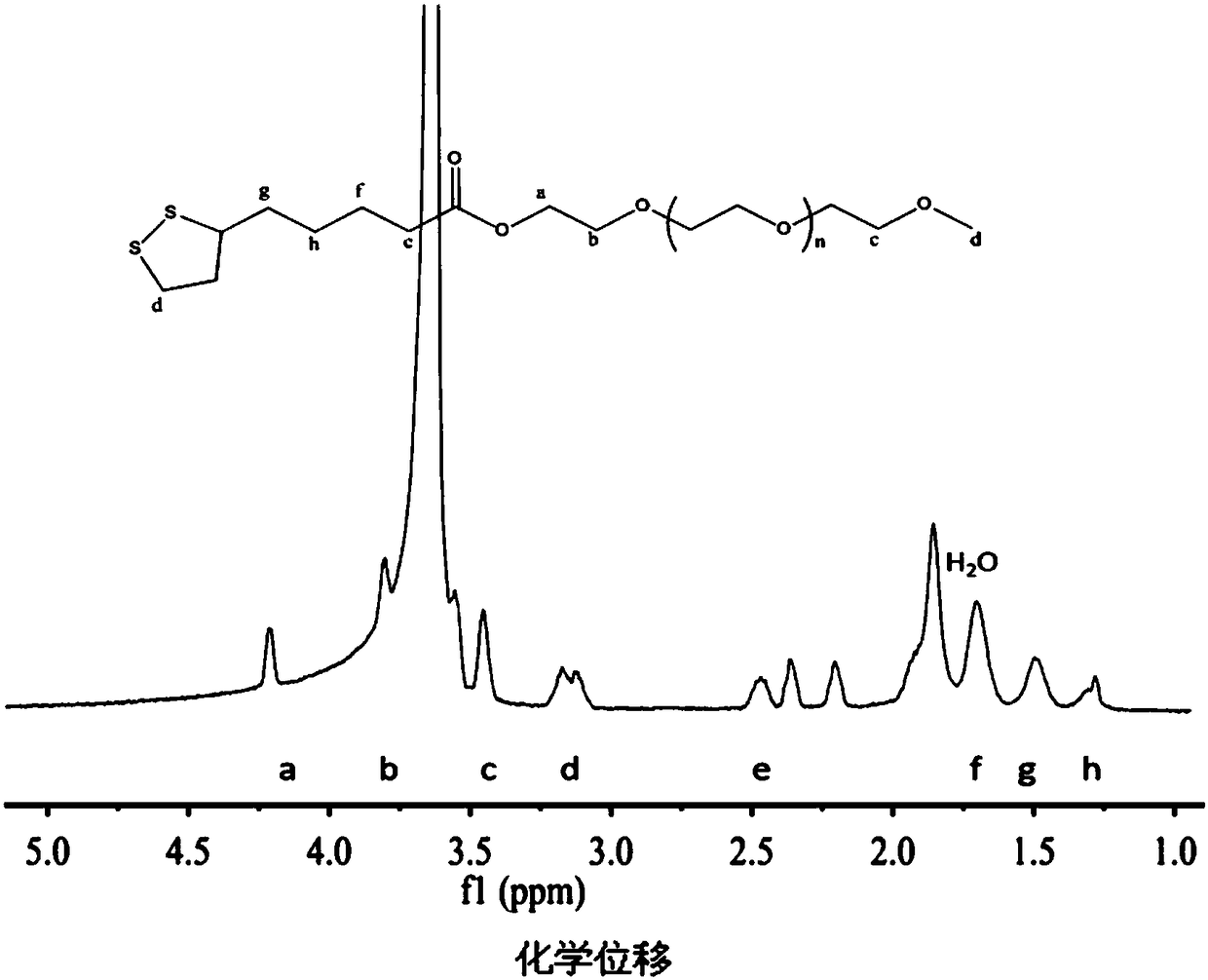A kind of nano-gold CT contrast agent for early diagnosis of liver cancer and preparation method thereof
An early diagnosis and nano-gold technology, applied in the field of biomedicine, can solve problems such as poor stability and unsuitability for animal CT experiments, and achieve the effects of improving stability, enrichment and tissue penetration, and good biocompatibility
- Summary
- Abstract
- Description
- Claims
- Application Information
AI Technical Summary
Problems solved by technology
Method used
Image
Examples
Embodiment 1
[0045] Example 1: Preparation of nano-gold CT contrast agent for early diagnosis of liver cancer
[0046] 1) LA-PEG 2k Synthesis: Weigh 2 g of single-ended methoxy mPEG 2k -OH and 0.206g lipoic acid (LA) (the molar ratio is LA:mPEG 2k -OH=5:1) was added to a 50mL round bottom flask, and 960mg of 1-ethyl-(3-dimethylaminopropyl)carbodiimide hydrochloride (EDC.HCL) and 610mg of 4 - Dimethylaminopyridine (DMAP), dissolved in 30 mL of dichloromethane (DCM). Stir in an ice-water bath for 30 minutes, then react in a water bath at 35°C for 2 days. After the reaction, dichloromethane was removed by rotary evaporation. The remaining solid was dissolved in distilled water, transferred to a dialysis bag (MWCO 2k) and dialyzed for two days. lyophilized to obtain LA-PEG 2k White powdery solid. Characterized by NMR, see attached image 3 .
[0047] 2) LA-PEG 4k and LA-PEG 10k The synthesis of: method is the same as step 1.
[0048] 3) Preparation of AuNPs: Weigh 59 mg tetrachloro...
Embodiment 2
[0058] Example 2: Nano-gold CT contrast agent ligand shielding-deshielding investigation:
[0059] 1) Assembly-disassembly investigation of nano-gold CT contrast agent
[0060] For gold nano-CT contrast agent, its assembly-disassembly properties under normal tissue (pH 7.4) and tumor conditions (pH 6.8) were investigated. In the experimental group 1:4 (see attached figure 2 ) and control group 1 as an example, the details are as follows: add NaOH solution (pH 13) to pH 8-9 dropwise into the gold nanometer solution, and after the Tyndall phenomenon is significantly enhanced in the system, take 400 μL of the assembly solution and add 800μL buffer solution HEPES pH 7.4 and HEPES pH 6.8, using dynamic light scattering (DLS) to investigate the particle size at different pHs, the particle size of the assembly is 100-200nm, and the particle size of the disassembly is 30-40nm, to illustrate the assembly of the system- disassembly properties. Then the pH of the solution was adjuste...
Embodiment 3
[0066] Example 3: Investigation on Concentrated Stability of Nano-gold CT Contrast Agent:
[0067] Batch centrifugation is used to concentrate the modified nano-gold solution (ie nano-gold CT contrast agent). For the first centrifugation (25,000 rpm, 45 minutes), the batch of nano-gold liquid is concentrated about 20 times; for the second centrifugation (15,000 rpm, 60 minutes), the concentrated solution obtained by the first centrifugation is further concentrated about 8 times. Finally, the nano-gold concentrated solution (0.15M) with a concentration (0.1M) suitable for CT imaging of tumor-bearing mice was obtained. Precipitation occurred in the experimental group 1:0 and the experimental group 1:2, which indicated that the contrast agent had poor stability at the contrast concentration and was not suitable for in vivo CT imaging. The test results are attached Figure 10 .
[0068] Combining Example 2 and Example 3, it is confirmed that the gold nano-CT contrast agent suit...
PUM
 Login to View More
Login to View More Abstract
Description
Claims
Application Information
 Login to View More
Login to View More - R&D
- Intellectual Property
- Life Sciences
- Materials
- Tech Scout
- Unparalleled Data Quality
- Higher Quality Content
- 60% Fewer Hallucinations
Browse by: Latest US Patents, China's latest patents, Technical Efficacy Thesaurus, Application Domain, Technology Topic, Popular Technical Reports.
© 2025 PatSnap. All rights reserved.Legal|Privacy policy|Modern Slavery Act Transparency Statement|Sitemap|About US| Contact US: help@patsnap.com



